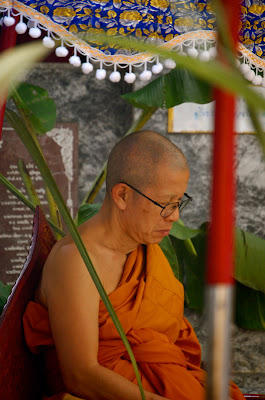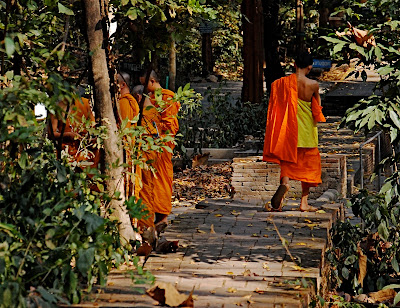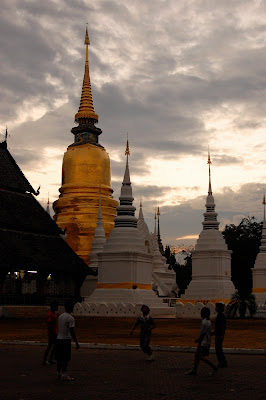
 "From a certain viewpoint, religion is a little bit of a luxury. If you have religion, very good; even without religion you can survive and you can manage, but without human affection we can't survive.
"From a certain viewpoint, religion is a little bit of a luxury. If you have religion, very good; even without religion you can survive and you can manage, but without human affection we can't survive.Although anger and hatred, like compassion and love, are part of our mind, I still believe the dominant force of our mind is compassion and human affection. Therefore, usually I call these human qualities spirituality. Not necessarily as a religious message or religion in that sense.
.. If we practice religion properly, or genuinely, or religion is not something outside but in our hearts. The essence of any religion is a good heart. Sometimes I call love and compassion a universal religion. This is my religion. Complicated philosophy, this and that, sometimes create more trouble and problems. If these sophisticated philosophies are useful for the development of a good heart, then good: use them fully. If these complicated philosophies or systems become an obstacle to a good heart then better to leave them. This is what I feel."
The Dalai Lama delivered these remarks almost 20 years ago, on September 14th, 1990, at a four day symposium on religion and the environment hosted by Middlebury College in Vermont.
I remember being surprised that day because the setting was the cavernous field house rather than the beautiful chapel atop a rise overlooking the campus. We got there early but the folding chairs, arranged in orderly grids facing the raised stage, were already half filled. We- I went with Mary and other friends, took center right seats almost half way back.
The stage was set with a long table, facing the audience, for perhaps twenty people representing a community of internationally respected scientists, prominent religious figures and other guest speakers. Near the center of the table was a place for the Dalai Lama. It was such an extraordinary gathering that I still have vivid images of it. Some things you just never forget.
He arrived via a side entrance off to the left, made his way to the middle aisle, and slowly- smiling, waiing, touching, made his way toward the stage. He passed within thirty feet of us and I remember that there was no sound in the huge, packed auditorium, it was absolutely, electrically, quiet- as if the very air was charged with the energy of this small man. I also remember thinking that this was as close to God as I was ever going to get.
Later, at a question and answer session, someone asked him if he truly believed in the sacredness of all life.. He laughed- he almost giggles, and said yes, but he had to admit he had some issues with bedbugs and mosquitos. He seemed a bit more human then!
That brief glimpse, nearly twenty years ago, of this extraordinarily loving and compassionate man was my introduction to Buddhism and to monks.
Later in the same week, at the request of a teacher who was Buddhist- her name was Shelly, the sister of the Dalai Lama came to visit our small (K-6, 126 students) school in the farming community of Bridport, Vermont. She came to our 7th grade classroom to look at the prayer flags we had created, spoke and answered question, and, before she left, wrote a short prayer on our blackboard. Afterward no one would erase it. The prayer stayed on the board until the end of the school year- nine months.
The photo of the Dalai Lama portrait was taken in a small temple in the Kashmir region of northern India. The three pictures of the monks I took up on the mountain at Wat Doi Suthep, and the one of the monk with the musical instruments was taken next door at Wat Suan Dok.
They represent for me what had been, for most of my life, my image of monks- ascetic, monastic, mysterious and distant.
To some extent that's still true, but living in Thailand, traveling a little in Laos and India, and especially being here next to Wat Suan Dok, has broadened those perceptions, removed some of the filters, and fleshed out those images.
Wat Suan Dok seems to me a younger monk place. Sometimes I see the older monks meeting at Pun Pun Restaurant, going to and from the administration buildings, and I hear them leading prayers at the big temple in the evening. Recently, while Duong and I were doing our evening visit on the wat green, an elderly monk was out walking around. He said hello, asked us how we were doing, lingered a bit, and then moved on. Afterward Duong told me he was the head monk at the wat.
But most of the monks I see are students who either reside here or commute from other wats for classes. Like other university students some of them look new and lost while others move about easily with the assuredness of graduates to be.
And like students everywhere they like to hang out. When they are not in class during the day they gather around the food stalls or beverage stands, or sit around tables under the trees.
In the evening it's a little different- after prayers many are in the dorms studying, but a few still drift out to the green at dusk to quietly socialize or find a peaceful spot to read or meditate.
Most have mobile phones. Many have MP3 players. And it is becoming common to see the monks here carrying laptops. Passing by the dorms at night, the glow of computer LCD displays flickers in the windows. When I make new friends we exchange email addresses as well as telephone numbers.
And like any other place we might frequent I see familiar faces, exchange nods or smiles, and then, if I don't see them for awhile, wonder if they are still around.
Sometimes I would see the monk pictured on the right. We never spoke to each other but we always nodded hello- the same routine for months. Then one time I was taking pictures during student days and I saw him sitting by himself. With the flowers overhead and the good light it was a beautiful setting. I asked him if I could take a picture and he nodded yes. We still have never had a conversation.
Student days at the Wat are one of the highlights of the year. The monks take nearly a week to set up the pavilions, stages, display booths and workshop venues. Parking lots are transformed into plazas, sound systems set up, and flower arrangements strategically placed. It is a big deal for the monks as well as the visiting students.
Not only do the young monks set up the workshops, but they also participate in them with the students. Along with the busloads of regular students, monks from other wats come to join in. It is traditional in Thai culture for all males to spend a period of time as a monk- whether it be for a week, a month or longer, so sometimes there are monks at Wat Suan Dok who appear to be ten years old or younger. Whatever their age, the workshops are designed to keep everyone interested.
There are no females in a few of the pictures here. Although there are Buddhist nuns who take vows similar to those of the monks, females are not allowed to make physical contact with monks. Even when giving something to a monk a woman will place it on a surface in front of him rather than pass it to him directly.
Every morning at dawn the monks go barefoot and silently out into the community to beg for food. Each of them carries an alms bowl, again, so that food can be placed in it rather than given directly to the monk.
Almost all of the younger monks wear the bright orange robes you see in the pictures. But many of the older monks can be seen in mustard yellow or muted brown cloth. So I asked my friend Tunnee about the different colored robes the monks wore.. if there was any significance to them. He laughed and said "Yes, it was whatever you felt like putting on in the morning!" I still don't know whether he was kidding me or not.
Traditionally, robes were the cheapest garb someone could wear, so ordained monks covered themselves in pieced together cloth that was colored with the cheapest dye available. In Kashmir the cheapest color was dark red so monks there wear dark red robes. Other regions had different dyes that were less expensive so the color of ordained monk's garb varied from region to region.
It was Thoreau, an ascetic of a different sort, who said "All men live lives of quiet desperation." A stretch maybe, but we all certainly have our temptations and weaknesses- foibles seems a nicer way of putting it. Monks are no exception.
Sometimes, walking by an older monk in the evening, the smell of cigarette will be drifting in the air. There is an eatery nearby where a most charming and assured young lady draws a small gathering. And, since monks eat no solid food after noon, sweets of a different sort can give rise to other cravings.
Late one afternoon I was visiting at another wat. I was sitting at the top of a brick stairway when a young monk passed.
It was another one of those times when the light was good so I started taking pictures. When he saw a group of older monks ahead of him he hesitated for a second or two, and his hand went nervously to a back pocket in his robe. Then, seemingly reassured, he walked on down and eased past the group of senior monks.
Once he was beyond them and out of their sight his hand went once again to his back pocket. He took something out and not long afterward a wrapper fluttered to the ground.
But as the Thais say.."Mai pen rai.": literally "no problem.. don't worry about it.. it doesn't matter!" Whatever it was that he did or didn't eat, there would be no finger pointing or criticism. Buddhists believe that if we don't get it right this time around there will be endless opportunities until we do find true contentment. How long it takes is up to us.
Every year in February, Chiang Mai has the Royal Flora Festival- Thailand's version of the Rose Bowl Parade and the National Arboretum rolled into a three day spectacle of flowers, floats, color and cameras.
Thais, including monks, love this stuff. It draws folks not only from other towns and cities in Thailand, but also from neighboring countries.


 Sometimes when we are hashing, or out scouting for a run, we come across trails that have been swept clear or even carefully landscaped. It usually means that there is a wat nearby and that monks are tending them. What we might consider menial or boring labor, the monks may see as opportunities for reflection or merit-making.
Sometimes when we are hashing, or out scouting for a run, we come across trails that have been swept clear or even carefully landscaped. It usually means that there is a wat nearby and that monks are tending them. What we might consider menial or boring labor, the monks may see as opportunities for reflection or merit-making.

For me it was the usual photographic adventure- maybe about a million pics taken, and 99% of them were, of course, National Geographic quality. Luckily for all of us there were only a few of monks!

Umbrellas serve both function and fashion. During the dry season many people carry them for protection from the intense and relentless sun. Like the sling bags they carry, umbrellas can compliment monk's robes or provide a colorful contrast. And often they make for beautiful photographs.
 Sometimes when we are hashing, or out scouting for a run, we come across trails that have been swept clear or even carefully landscaped. It usually means that there is a wat nearby and that monks are tending them. What we might consider menial or boring labor, the monks may see as opportunities for reflection or merit-making.
Sometimes when we are hashing, or out scouting for a run, we come across trails that have been swept clear or even carefully landscaped. It usually means that there is a wat nearby and that monks are tending them. What we might consider menial or boring labor, the monks may see as opportunities for reflection or merit-making.















































